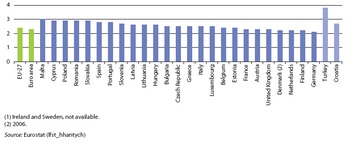Archive:Housing statistics
Housing, water, electricity, gas and other fuels form the main expenditure item of household budgets in the European Union (EU). Questions of social housing, homelessness or integration play an important role within the social policy agenda. However, the EU does not have any responsibilities in respect of housing; rather, national governments have the responsibility for developing their own housing policies. Many countries face similar challenges: for example, how to renew housing stocks, how to plan and combat urban sprawl and promote sustainable development, how to help young and disadvantage groups to get on the housing ladder, or how to promote energy efficiency among house-owners. The social and economic cost of the absence of decent housing is generally accepted to compromise the efficiency of a country or region. Indeed, decent housing, at an affordable price in a safe environment is likely to alleviate poverty and social exclusion.
Main statistical findings
The average number of persons living in a household in the EU-27 was 2.4 in 2007. The highest average in 2007 was recorded for Malta (3.0), the equivalent of almost one additional person per household when compared with the average in Germany (2.1), where the lowest value was recorded. Generally speaking, the northern Member States tended to report the lowest average number of persons per household, while there were higher figures among the Mediterranean countries and those countries which joined the EU since 2004.
There were wide ranging differences across the Member States as regards housing ownership status in 2006: in the Baltic Member States, Slovakia, Hungary, Slovenia and Spain more than 80 % of households owned their own house/flat, while there was a tendency for lower levels of ownership (and therefore a higher propensity to rent) in Germany, Austria, the Netherlands and Poland. It is difficult to pinpoint the reasons for such differences, as the distribution of households may be related to a range of factors including the degree of urbanisation, the quality of accommodation, or the supply of new or renovated housing.
Data sources and availability
The data used in this section are primarily derived from micro-data from EU statistics on income and living conditions (EU-SILC). From 2005 onwards, EU-SILC covers the EU-25 Member States as well as Norway and Iceland. Bulgaria, Romania, Turkey and Switzerland launched EU-SILC in 2006. The reference population of EU-SILC is all private households and their current members residing in the territory of the Member State at the time of data collection. Persons living in collective households and in institutions are generally excluded from the target population.
A household is defined in terms of shared household expenses. If household expenses are not shared, then the person(s) constitute separate household(s) at the same address. A household may comprise either one person living alone or a group of people, not necessarily related, living at the same address with common housekeeping, i.e. sharing at least one meal per day or sharing a living or sitting room. The average number of persons per private household is the number of persons living in private households divided by the number of private households; collective households such as boarding houses, halls of residence and hospitals and the persons living in them are excluded.
Context
Housing, water, electricity, gas and other fuels form the main expenditure item of household budgets in the European Union (EU) (see also Household consumption expenditure). Questions of social housing, homelessness or integration play an important role within the social policy agenda. The Charter of Fundamental Rights stipulates in Article II-94 that ‘in order to combat social exclusion and poverty, the Union recognises and respects the right to social and housing assistance so as to ensure a decent existence for all those who lack sufficient resources, in accordance with Community law and national laws and practices’.
However, the EU does not have any responsibilities in respect of housing; rather, national governments have the responsibility for developing their own housing policies. Many countries face similar challenges: for example, how to renew housing stocks, how to plan and combat urban sprawl and promote sustainable development, how to help young and disadvantage groups to get on the housing ladder, or how to promote energy efficiency among house-owners. The social and economic cost of the absence of decent housing is generally accepted to compromise the efficiency of a country or region. Indeed, decent housing, at an affordable price in a safe environment is likely to alleviate poverty and social exclusion.
Further Eurostat information
Publications
Main tables
- Living conditions and welfare
- Income and living conditions
- Main indicators
- Income distribution and monetary poverty
- Non-monetary poverty and social exclusion
- Income and living conditions
Database
- Income and living conditions
- Income distribution and monetary poverty
- Non-monetary poverty and social exclusion
- Households and living conditions
- Housing

